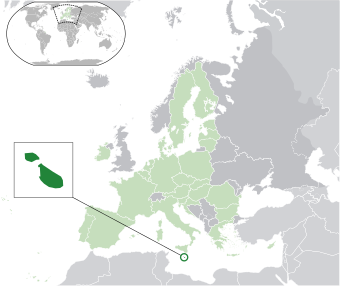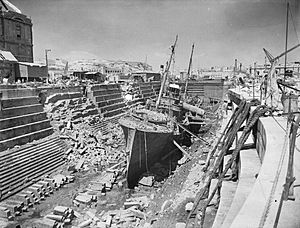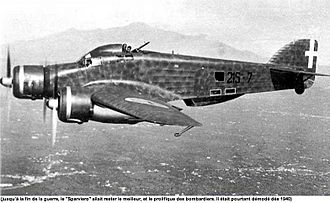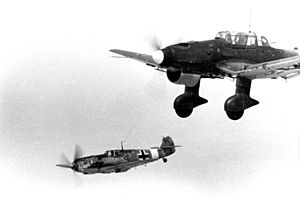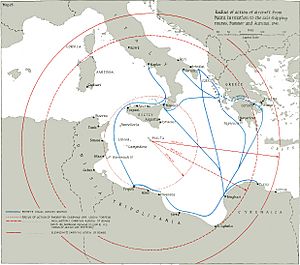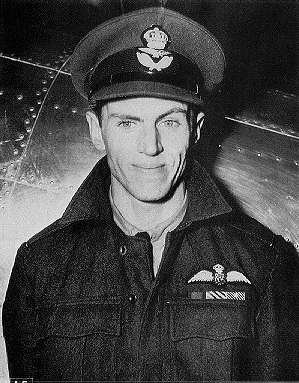Siege of Malta (World War II) facts for kids
Quick facts for kids Siege of Malta |
|||||||
|---|---|---|---|---|---|---|---|
| Part of the Mediterranean and Middle East Theatre of the Second World War | |||||||
 Service personnel and civilians clear bombing debris from Kingsway in Valletta in 1942 |
|||||||
|
|||||||
| Belligerents | |||||||
|
|||||||
| Commanders and leaders | |||||||
| Strength | |||||||
| 716 fighter aircraft over the course of the campaign | c. 2,000 aircraft over the course of the campaign | ||||||
| Casualties and losses | |||||||
| 369 fighters (air) 64 fighters (ground) 1 battleship 2 aircraft carriers 4 cruisers 19 destroyers 38 submarines 2,301 airmen killed or wounded 30,000 buildings destroyed or damaged 1,300 civilians killed |
357 German aircraft 175 Italian aircraft 72 percent of the Italian Navy transport fleet lost 23 percent of the Axis merchant fleet lost 2,304 merchant ships sunk 17,240 killed at sea ~50 German U-boats (in entire MTO) Italian submarine losses ~16 |
||||||
The Siege of Malta was a major military event during World War II. From June 1940 to November 1942, the island of Malta was under constant attack. Malta was a British colony and a very important island in the Mediterranean Sea.
The fight was between the air and naval forces of Fascist Italy and Nazi Germany (known as the Axis powers) against the Royal Air Force (RAF) and the Royal Navy (known as the Allies).
Malta was extremely valuable because it was a British base. From there, Allied planes and ships could attack Axis ships. These Axis ships were carrying important supplies and soldiers to North Africa. British Prime Minister Winston Churchill called Malta an "unsinkable aircraft carrier".
The Axis powers tried to bomb or starve Malta into giving up. They attacked its ports, towns, and cities. They also attacked Allied ships trying to bring supplies to the island. Malta became one of the most heavily bombed places during the war. German and Italian air forces flew 3,000 bombing raids. They dropped 6,700 tons of bombs on the Grand Harbour area alone over two years.
The Axis planned to invade Malta (called Operation Herkules). This plan involved German and Italian soldiers landing on the island. However, the invasion never happened. Allied convoys managed to bring supplies and reinforcements to Malta. The RAF also bravely defended Malta's airspace.
In November 1942, the Axis powers lost a big battle in North Africa. This was the Second Battle of El Alamein. The Allies also landed forces in North Africa. Because of this, the Axis had to move their forces to fight in Tunisia. This meant they stopped attacking Malta, and the siege effectively ended.
After the siege, in December 1942, Allied forces from Malta went on the attack. By May 1943, they had sunk 230 Axis ships. This was the highest sinking rate for the Allies during the war. The Allied victory in Malta was very important. It helped the Allies win in North Africa.
Contents
- Why Malta Was Important in World War II
- Italian Attacks Begin (June–December 1940)
- German Air Force Arrives (January–April 1941)
- Allied Recovery and Offensive (April–October 1941)
- German Air Force Returns (December 1941 – August 1942)
- Allied Victory (October–November 1942)
- Aftermath of the Siege
- See also
Why Malta Was Important in World War II
Malta was a strong military and naval base. It was the only Allied base between Gibraltar and Alexandria, Egypt. Before the war, it was a stop for British trade ships going to Egypt and the Suez Canal. Even when the trade route was closed, Malta remained a key base. It was used to attack Axis ships and targets in the central Mediterranean.
Because Malta was so close to Italy, the British moved their main naval headquarters. The British Mediterranean Fleet moved from Valletta, Malta, to Alexandria in Egypt in 1939. This left Malta with less naval protection.
Malta is a small island, about 27 by 14 kilometers (17 by 9 miles). In 1940, about 250,000 people lived there. Most people lived near the Grand Harbour. This area was very crowded. Valletta, the capital, had 23,000 people in a small space. The Three Cities, where the Malta Dockyard was, had 28,000 people. These small, crowded areas were hit hardest by the bombings.
Before the war, some thought Malta could not be defended. The Italian and British navies were similar in strength. However, Italy had many more submarines and aircraft. The British had to protect the Suez Canal and Gibraltar. In 1939, the Mediterranean Fleet moved to Egypt. This left Malta without its main naval defense. The Maltese people worried if Britain would truly defend them.
Despite worries, Britain decided to send more anti-aircraft guns and fighter planes to Malta in 1939. In May 1940, some British leaders even thought about giving Malta to Italy to make peace. But Winston Churchill convinced them not to. Britain itself was in danger, so Malta's defense was not the top priority. Only six old Gloster Gladiator biplanes were on the island. Six more were in crates. On June 10, 1940, Italy declared war on Britain and France.
Italy wanted to expand its power in the Mediterranean and Africa. When France surrendered in June 1940, Italy gained a big advantage in naval and air power. Hours after declaring war, Italy dropped its first bombs on Malta. After France's surrender, Italy tried to invade Egypt. But the British fought back and defeated them.
Adolf Hitler then decided to help his Italian ally. In February 1941, the German Africa Corps (DAK) was sent to North Africa. British planes and submarines from Malta were a big threat to Axis supply lines. Both sides knew how important Malta was for controlling the central Mediterranean.
In 1940, Italy could have invaded Malta and taken control. This would have given them control of the central Mediterranean. It would have split British bases at Gibraltar and Alexandria. But Italy was hesitant. The Battle of Taranto also weakened the Italian navy. So, Italy decided to try and cut off Malta instead. They believed air power was the key to defeating the island.
Italian Attacks Begin (June–December 1940)
Italian Air Raids on Malta
Italy chose air power to attack Malta. The Regia Aeronautica (Italian Air Force) started bombing the island from bases in Sicily. On the first day, 55 Italian bombers and 21 fighters flew over Malta. They dropped 142 bombs on the three airfields. At first, Malta had no air opposition. The only defending fighters were old Gloster Sea Gladiators. Ten Gladiators were put together from crates. Only three could fly at once, and they were famously named 'Faith', 'Hope', and 'Charity'. Their pilots were not even fighter pilots. One Gladiator was shot down, but the others shot down several Italian planes.
Italian planes flew very high, around 6,100 meters (20,000 feet). British ships fired at them. Later, 38 more bombers attacked the capital, Valletta. The raids aimed to scare the people, not just damage military targets. Eight raids happened on the first day. The bombing did not cause much damage, and most casualties were civilians. There were no RAF planes ready to meet the attackers. No RAF airfield on Malta was fully ready yet.
Despite this, at least one RAF Gladiator fought against 55 Italian bombers and 20 fighters on June 11. It surprised the Italians. On June 12, an Italian plane on a spy mission over Malta was shot down.
On June 19, 12 Fairey Swordfish torpedo bombers arrived at Hal Far. They had escaped from France. These planes became the start of Malta's first offensive air force. Before June ended, they attacked Sicily. They sank an Italian destroyer, damaged a cruiser, and destroyed oil tanks.
By early July, the Gladiators were joined by Hawker Hurricanes. These defenses were organized into No. 261 Squadron RAF. In August, 12 Hurricanes were brought to Malta by a British aircraft carrier. Another attempt to bring 12 Hurricanes in November failed. Eight Hurricanes were lost because they ran out of fuel.
By the end of 1940, the RAF claimed 45 Italian planes shot down. The Italians admitted losing 23 bombers and 12 fighters. Many more planes were damaged.
Italian Invasion Plans
In 1938, Italy's leader, Mussolini, thought about invading Malta. His plan, DG10/42, involved 40,000 men. He expected to lose almost all the landing ships. Landings would happen in the north, attacking the Victoria Lines. A smaller landing would be on Gozo and Comino. The entire Italian navy and 500 aircraft would be involved. But they lacked supplies, so the plan seemed impossible.
After Germany's success in France in 1940, the plan was reduced to 20,000 men with tanks. The defeat of the Allies in France gave Italy a chance to take Malta. But Italian spies thought Malta's defenses were stronger than they were. Mussolini also believed Britain would make peace, so an invasion would not be needed.
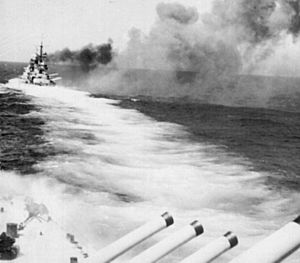
The Italian navy was also hesitant to act. They believed they could keep the British fleet trapped in Alexandria. Italy also lacked crude oil. Germany took most of the oil from Romania, leaving little for Italy. This limited large naval operations and training. By early 1941, Italy only had enough fuel for seven months.
On the other hand, British confidence grew as aircraft became more important in naval battles. On July 9, 1940, the Battle of Calabria was the only time the main Italian and British fleets fought directly. Both sides claimed victory, but it was not clear who won. This battle showed the Maltese that Britain still controlled the seas. This was confirmed again in March 1941. The Royal Navy decisively defeated the Italian Navy in the Battle of Cape Matapan.
British Counter-Attacks from Malta
When Britain realized Italian air attacks were not very effective, they sent more planes to Malta. The island's potential as a base was clear. More Hurricane fighters, Martin Marylands, Sunderlands, Wellingtons, Swordfish, and submarines arrived. This gave Malta a stronger offensive force. The Wellingtons arrived in October 1940.
Meanwhile, Italy's invasion of Egypt failed. The British counter-attack, Operation Compass, destroyed several Italian army divisions. This forced Italy to move many air units from Italy and Sicily to North Africa. This eased the pressure on Malta. Britain could now focus on attacking, not just defending.
In November 1940, the British navy and air force attacked Italian naval forces. This was the Battle of Taranto. British torpedo bombers disabled many Italian warships. The Italian fleet moved to Naples, out of reach of British planes. This was a big victory for Britain.
British submarines also began attacking. Small U-class submarines started operations in June. Larger submarines also operated but suffered heavy losses. The new submarine force was called the Tenth Submarine Flotilla. They had some successes, but many were lost to mines. On January 14, 1941, more U-class submarines arrived, and the submarine attacks increased.
German Air Force Arrives (January–April 1941)
Germany Steps In
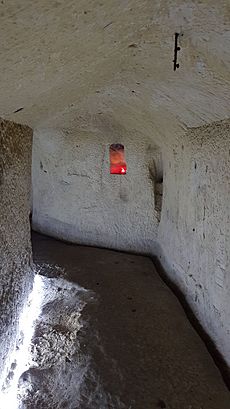
Germany got involved in Malta because Italy was losing in North Africa. Hitler had to help his ally to keep control of the Middle Eastern oil fields. The German Africa Corps (DAK) was sent to North Africa in February 1941. They launched a counter-attack and pushed the British back into Egypt. But getting supplies to Africa meant shipping them across the sea. This made Malta a big threat to German supply lines.
So, the German Air Force High Command (OKL) sent Fliegerkorps X to Sicily in January 1941. Their job was to attack Allied ships around Malta and RAF bases on the island. This would make it easier for Axis supplies to reach North Africa.
British submarines failed to stop German ships carrying troops to Libya. Only one German ship was damaged. On February 9, 1941, three submarines missed the same convoy. A big reason for Axis success was naval mines. Italy laid 54,000 mines around Malta to stop supplies from reaching the island. These mines were very dangerous for British submarines.
From January to April 1941, the Axis sent 321,259 tons of supplies to Libya. Almost all of it (94%) reached port safely. Of 73,991 men sent by sea, 97% arrived in Africa. On December 10, 1940, Fliegerkorps X was ordered to Sicily. By January 1941, they had 255 aircraft, including many dive and medium bombers.
On January 2, 1941, the first German units arrived in Sicily. These were two groups of Junkers Ju 87 Stuka dive bombers. There were about 80 Ju 87s. This led to a big increase in bombing raids on Malta. The Germans were ordered to sink British aircraft carriers. Days later, they aimed to sink the new carrier HMS Illustrious. This carrier had played a key role in the Battle of Taranto.
Attacks on HMS Illustrious
German pilots practiced attacking mock-ups of the carrier. They believed four direct hits would sink it. On January 6, they got their chance. The British launched Operation Excess, a series of convoy operations. On January 10, the convoys were in range of the Ju 87 bases. 43 Ju 87s attacked the carrier. Ten Italian bombers had drawn away the carrier's fighter planes. The Ju 87s scored six hits on the Illustrious. One hit destroyed a gun, another hit near the bow, and a third destroyed another gun. Two more hit the lift, damaging planes below deck and causing explosions. Another bomb went through the armored deck and exploded deep inside. The attack lasted six minutes. It killed 126 crew members and wounded 91.
Badly damaged, the Illustrious headed for Malta. Italian torpedo bombers also attacked it near Malta, but anti-aircraft fire drove them off. The British knew the Germans were in Sicily, but this information was not passed to the navy. The RAF on Malta was too weak to stop a major German air attack. They only had 16 Hurricanes and a few Gladiators.
On January 11, 10 more Ju 87s were sent to sink Illustrious. They found the light cruisers HMS Southampton and Gloucester. Both were hit. Southampton was so badly damaged that its escorts had to sink it. For the next 12 days, workers in Malta's Grand Harbour repaired the carrier under constant air attack. On January 23, it left Grand Harbour and reached Alexandria two days later. The carrier then sailed to America for a year of repairs.
The German Air Force failed to sink the carrier. Their losses were small. But they showed the British how effective land-based air power could be. Britain then pulled its heavy warships out of the central Mediterranean. Both the British and Italian navies learned from these battles.
German and Italian Air Superiority
In February, German Messerschmitt Bf 109 E-7 fighters arrived. These pilots were experienced and well-trained. This quickly led to more RAF losses. The Allied pilots on Malta had little combat experience. Their Hawker Hurricanes were old and worn out. For four months, the German fighters had few losses. The German Air Force claimed 42 air victories. The RAF Hurricanes were kept flying by using parts from damaged planes. Their performance was already worse than the Bf 109E-7. Five Hurricanes arrived in March, but five Hurricanes and five pilots were lost.
On March 1, German attacks on airfields destroyed all the Wellingtons. British warships and flying boats could not use Malta for attacks. The main fighter squadrons were under great pressure. There were many raids each day. Over 107 Axis attacks happened in February and 105 in March. Bf 109 fighters shot at anything moving on the ground. By February, about 14,600 men had volunteered. Food rationing began, lowering morale. All males aged 16 to 56 were forced to join the army.
The Allies had a success in April. They won the Battle of the Tarigo Convoy. On the night of April 15/16, British destroyers sank several Axis ships. The British lost one destroyer, the Mohawk. This strike force was based in Malta despite the air attacks. It had good success. On May 21, the force was sent to the Battle of Crete. It took several months for the weakened force to return.
More supplies reached Malta through convoys. Operation Tiger brought 295 tanks and 24,000 tons of oil for North Africa. Only one ship was lost to a mine. These supplies were completed on May 12. German and Italian bombers tried to attack the convoy and Malta but failed.
The Axis air forces kept their air superiority. Hitler ordered Fliegerkorps X to protect Axis shipping. They also had to stop Allied shipping and neutralize Malta. About 180 German and 300 Italian planes were involved. The RAF struggled to fly more than six or eight fighter missions. Sometimes, 12 Hurricanes were flown in from British carriers, but they were quickly used up. By mid-May, the central Mediterranean was closed to Allied shipping again. The German Africa Corps in North Africa received reinforcements. Only 3% of their supplies were lost. From April 11 to May 10, 111 Axis raids hit military targets on Malta. Most heavy equipment in Grand Harbour was destroyed. Workshops could only work at 25% to 50% efficiency.
In the first four months of German operations, the German Air Force dropped 2,500 tons of bombs on Malta. This was much more than Italy had dropped. More than 2,000 civilian buildings were destroyed. Only 300 were destroyed during the Italian siege. Civilian casualties were low. After the bombing of HMS Illustrious, most civilians moved to the countryside. By May 1941, nearly 60,000 people had left the cities. About 70% of churches on the island were destroyed by the end of 1941. The British focused on protecting military targets. Few shelters were available for civilians. Eventually, 2,000 miners and stonemasons built public shelters.
German Forces Leave Malta
In April, Hitler had to send forces to the Balkans. This included the German invasion of Yugoslavia and the Battle of Greece. Heavy German losses in the Battle of Crete convinced Hitler that paratrooper landings were too risky. German airborne forces never did such operations again. This was important for Malta. It meant the island was only at risk from a siege, not an invasion.
In June, Hitler attacked the Soviet Union (Operation Barbarossa). Fliegerkorps X left for the Eastern Front. The Italian Air Force was left to continue its air campaign against Malta. By early May 1941, the German Air Force had flown 1,465 bomber, 1,144 fighter, and 132 reconnaissance missions. They lost only 44 planes.
Allied Recovery and Offensive (April–October 1941)
New Leadership for the RAF
On June 1, Air Vice Marshal Forster Maynard, Malta's Air Officer Commanding, was replaced by Air Commodore Hugh Lloyd. When Lloyd arrived, he found very little to work with. But he wanted to go on the offensive. Outside his office, he hung a sign that said, "Less depends on the size of the dog in the fight than on the size of the fight in the dog."
Within hours, Lloyd inspected the airfields and workshops. The island was in worse shape than he thought. German air activity had slowed, so the number of aircraft had increased. But the RAF still had fewer than 60 planes. Maintenance was very hard. There were almost no spare parts. Airfields were too small, and there was no heavy equipment. Even simple tools like hammers were hard to find. All refueling had to be done by hand. There was little protection for equipment. Most planes were grouped together on runways, making them easy targets. Lloyd said, "a few bombs on Kalafrana in the summer of 1941 would have ruined any hope of Malta ever operating an air force."
Normally, protecting air defenses and naval assets would be the priority. Bringing in more supplies would have made more sense before attacking the enemy. But this was an important time. In North Africa, the German Africa Corps was advancing towards the Suez Canal. RAF forces on Malta could not sit still. They could slow down Rommel's advance by attacking his supply lines. Malta was the only place where British attack planes could launch their missions. Lloyd's bombers and a small group of submarines were the only forces available to bother Rommel's supply lines until autumn. Only then did surface fleets return to Malta.
Allied Reinforcements Arrive
Malta built up an 8–15 month supply of essential civilian goods. Operation Substance in July 1941 was very successful. It brought in spares and aircraft. About 60 bombers and 120 Hurricanes were now available. Around 65,000 tons of supplies reached Malta in July. No supplies were sent in August. But Operation Halberd in September 1941 brought in 85,000 tons of supplies. Nine merchant ships were escorted by one aircraft carrier, five cruisers, and 17 destroyers. One cargo ship was sunk, and a battleship was damaged. This convoy was crucial for saving Malta.
In mid-1941, new squadrons were formed. Defenders received the first Hurricane Mk IICs with cannons. Naval carriers brought in 81 more fighters in April–May. By May 12, there were 50 Hurricanes on the island. By early August, Malta had 75 fighters and 230 anti-aircraft guns. Bristol Blenheim bombers also arrived and began attacking.
Besides preparing for attacks and reinforcing the RAF, Lloyd also fixed many problems. Thousands of Maltese and 3,000 British soldiers helped protect the airfields. Even technical staff and flight crews helped. Dispersal strips were built. Repair shops moved underground from dockyards and airfields. Underground shelters were also created. On July 26, Italian fast attack craft tried a night attack. British radar detected them early. Coastal artillery at Fort Saint Elmo fired on the Italians. 15 men were killed, 18 captured, and most boats were lost.
Allied Offensive Operations
The Allies launched attacks from Malta. About 60% of Axis shipping was sunk in the second half of 1941. The German Africa Corps was not getting the 50,000 tons of supplies it needed each month. This meant they could not fight back against a strong British attack in Operation Crusader.
In July, the Axis landed 62,276 tons of supplies, half of June's amount. In September 1941, British naval air squadrons sank or damaged two large ships. British intelligence found that 3,500 tons of bombs, 4,000 tons of ammunition, and 5,000 tons of food were lost. A tank workshop and plane engines were also lost. More success followed later in the month. British losses from Italian anti-aircraft fire were often heavy. British bombers were asked to attack at mast-height. This increased accuracy but made them easier targets. Losses averaged 12% during this time. Wellington bombers hit Axis convoys. With British submarines, the RAF and naval air arm sank 108 Axis ships between June and September. In September, 33% of 96,000 tons of supplies were lost to British attacks.
In November 1941, the arrival of Force K of the Royal Navy helped a lot. They sank all the ships in the Battle of the Duisburg Convoy. This almost blocked Libyan ports. Soon after, Force B arrived in Malta. Joint operations with the RAF were very effective. In November 1941, Axis fuel losses were 49,365 tons out of 79,208 tons. British Wellingtons with radar helped direct British naval forces to convoys.
On November 13, the carrier HMS Ark Royal was sunk by a German submarine. Twelve days later, the battleship HMS Barham was sunk by a submarine. On December 19, British ships ran into a minefield. The cruiser HMS Neptune sank, and HMS Aurora was damaged. The destroyer HMS Kandahar was also mined and later sunk. After this disaster, surface ships were pulled out of the central Mediterranean in January 1942.
While Italian bombing was successful again, the German Air Force returned in force in December 1941. They renewed their heavy bombing. The German navy sent almost half of its submarines from the Atlantic to the Mediterranean. By December 15, half of these submarines were in or on their way to the Mediterranean. They had to pass British forces in Gibraltar. Before the German Air Force returned, the RAF on Malta claimed 199 planes shot down from June 1940 to December 1941. They lost at least 90 Hurricanes and other planes in air combat. Many more were destroyed on the ground.
German Air Force Returns (December 1941 – August 1942)
Kesselring Takes Command
By June 1941, German General Geisler had moved to Libya to support the German Africa Corps. In the Mediterranean, the Allies recovered and began attacking Axis ships. The high losses of supplies affected Geisler's ability to support Rommel. This caused tension between the German army and air force. Geisler was supposed to return to Sicily with his remaining air force. But the Germans changed their mind. On October 6, Geisler did extend his air responsibilities to cover the Tripoli-Naples sea route.
On October 2, Hermann Göring, head of the German Air Force, met with his Italian counterpart. They discussed sending reinforcements. Göring agreed to send Luftflotte 2 and its commander Albert Kesselring to Sicily from the Eastern Front. Kesselring became Commander-in-Chief South from December 1, 1941.
German Pressure and Spitfire Arrival
German Messerschmitt Bf 110s and Junkers Ju 88 night fighters arrived in Sicily. They quickly destroyed Malta's attacking force. In the first two months, about 20 RAF bombers and reconnaissance planes were shot down. Success against Axis shipping quickly stopped. The only notable success was the sinking of the large merchant ship Victoria by a Fairey Albacore on January 23.
Over the island, the RAF's defense was also under pressure. Kesselring began 1942 with a raid on New Year's Day. This was the 1,175th raid of the war. In January, the RAF lost 50 Hurricanes on the ground and eight shot down. Of 340 fighters that had been on the island, only 28 remained. The Axis conducted 263 raids that month. Fliegerkorps II grew to 390 aircraft in March, reaching a peak of 425.
One-third of all raids targeted airfields. At Ta' Qali, 841 tons of bombs were dropped. Germans used powerful bombs because they thought the British had an underground hangar. German fighters usually swept ahead of bombers to clear the skies. This worked, and they kept air superiority. Bombers suffered only small losses. The Italians supported the German Air Force, flying 2,455 missions in February and March.
British commanders asked for modern planes, especially Spitfires, to be sent to Malta. Pilots said Hurricanes were useless and Spitfires were their only hope. They claimed Germans flew in front of Hurricanes to show off their better planes. Squadron leaders said their inferior planes affected morale. Spitfires began arriving in March 1942.
Axis Invasion Plan for Malta
On April 29–30, 1942, Hitler and Mussolini approved a plan to invade Malta. It involved a German and an Italian airborne division. This would be followed by a sea landing of two or three divisions. The Italians and Kesselring made the invasion of Malta the top priority.
However, two main things stopped Hitler. First, Rommel, the German general in North Africa. Kesselring's bombing of Malta had secured supply lines to North Africa. Rommel was gaining ground in North Africa again. Rommel believed Malta should be invaded, but he insisted that conquering Egypt and the Suez Canal was more important. Second, Hitler himself was nervous. After the Battle of Crete in 1941, he was worried about using paratroopers. The Crete campaign had caused heavy losses for these units. So, he delayed making a decision. Kesselring complained. Hitler suggested a compromise. If the Egyptian border was reached again, the Axis could invade in July or August 1942. This would be during a full moon, good for a landing. Kesselring was frustrated but relieved the operation was postponed, not canceled.
RAF Gains Air Superiority
Before the Spitfires arrived, efforts were made to reduce losses. In February 1942, Squadron Leader Stan Turner arrived. He was an experienced combat leader. He introduced new tactics to reduce RAF losses. The old Hurricanes still struggled against the latest German Bf 109Fs and Italian Macchi C.202s. The Junkers Ju 88 bomber was also a tough enemy. But Hurricanes did sometimes win against Bf 109Fs.
On March 7, 1942, 16 Supermarine Spitfire Mk Vs flew to Malta from the aircraft carrier HMS Eagle. More Spitfires were delivered later. On April 13, another 47 Spitfires arrived. All but one reached the island. Spitfires were a match for Axis planes. But many delivered in March and April were destroyed on the ground and in the air. For five days in April, only one Spitfire was available to defend the island. For two days, there were none. The Germans watched their delivery and attacked heavily. By April 21, only 27 Spitfires were still flying.
The huge Axis bombings had also greatly weakened Malta's naval and air attack abilities. By March–April 1942, the German Air Force had gained air superiority. The Italian Air Force also attacked with determination. Often, three to five Italian bombers flew very low and dropped bombs precisely, despite RAF attacks and ground fire.
The Germans also found that British submarines were operating from Manoel Island, not Grand Harbour. They used their air superiority to attack the submarine base. Submarines had to spend most of their time underwater. Mine-laying by Axis planes also caused more submarine losses. By the end of March 1942, 19 submarines had been lost. In April, 150,389 tons of supplies reached North Africa from Italy. Hitler's plan to neutralize Malta by siege seemed to be working. Kesselring reported to the German High Command that "There is nothing left to bomb." Between March 20 and April 28, 1942, the Germans flew 11,819 missions against Malta. They dropped 6,557 tons of bombs. The Germans lost 173 aircraft.
The Allies moved to increase the number of Spitfires. On May 9, two carriers delivered 64 more Spitfires. Malta now had five full Spitfire squadrons. The impact of the Spitfires was clear. On May 9, the Italians reported 37 Axis losses. On May 10, the Axis lost 65 planes destroyed or damaged in big air battles. Hurricanes could focus on Axis bombers at lower heights. Spitfires, with their faster climb, fought enemy planes at higher levels. From May 18 to June 9, another 76 Spitfires were brought to Malta. With such a force, the RAF could handle any Axis attacks.
By spring 1942, the Axis air forces against Malta were at their strongest. But by the end of May 1942, the RAF's improved defenses took air superiority from the German Air Force. By then, Kesselring's forces were greatly reduced.
Axis Target Convoys
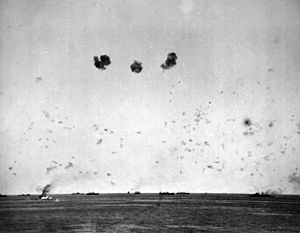
After the battles of May and June, air attacks decreased in August and September. While the RAF had won back air superiority, German pressure had allowed Axis convoys to resupply their army in North Africa. Malta seemed to be neutralized as a threat to their convoys. Rommel could now plan attacks in North Africa. He won a big victory at the Battle of Gazala.
Despite less direct air pressure on Malta, the island's situation was serious. It was running out of food and water. Bombing had damaged pumps and pipes. Clothing was also scarce. All livestock had been killed. People used curtains and old tires for clothes and shoe soles. Starvation was a real threat. Poor food and sanitation led to disease. Soldiers' food rations were also cut. Britain prepared to supply the island with two convoy operations.
In June, the Royal Navy sent two convoys to Malta. Operation Harpoon came from Gibraltar, and Operation Vigorous came from Haifa and Port Said. This was to split Axis naval forces. The western convoy lost a destroyer, three merchant ships, and a tanker. The Polish destroyer ORP Kujawiak was sunk by mines near Malta. The eastern convoy had to turn back after naval and air battles. The losses were heavy. Malta sent planes to attack the Italian fleet and German submarines. They sank a heavy cruiser and damaged a battleship. Two freighters from the western convoy reached Malta. They delivered 25,000 tons of supplies. Only two ships out of 17 delivered their cargo. 16 more Malta-based pilots were lost.
In August, Operation Pedestal brought vital relief to Malta. But it came at a heavy cost. It was attacked from sea and air. Many German and Italian planes attacked the convoy. Out of 14 merchant ships, nine were sunk. Also, the aircraft carrier HMS Eagle, one cruiser, and three destroyers were sunk. Despite the losses, the operation was vital. It brought much-needed war materials and supplies. British destroyers saved 950 of Eagle's crew. The Italian Air Force played a central role against the convoy.
Surface convoys were not the only supply line. British submarines also helped a lot. The submarine HMS Clyde was converted to carry supplies. She made nine supply missions to Malta. Her ability to carry large loads was very valuable.
Keith Park Takes Command
In July, Hugh Lloyd was replaced as RAF commander on Malta. A leader with experience in fighter defense was needed. Air Vice Marshal Keith Park replaced Lloyd. Park arrived on July 14, 1942, during a raid. Lloyd had asked him to wait, but Park landed anyway.
Park had faced Kesselring before during the Battle of Britain. In that battle, Park sent small numbers of fighters to fight the enemy. This meant there were always fighters in the air, and small groups were easier to move. It also helped save his forces. Over Malta, he changed his tactics. With many Spitfires, Park wanted to stop the enemy before they reached the island. Until then, Spitfires fought defensively. They would climb high and then attack over the island.
Now, with better radar and faster take-off times, more attacks were possible. Park used three squadrons. The first would attack the escorting fighters. The second would hit the close escort or the bombers. The third would attack the bombers head-on. Park's methods had an instant impact. His "Forward Interception Plan" forced the Axis to stop daylight raids within six days. The Ju 87s were completely pulled from operations over Malta. Kesselring responded by sending fighters at even higher altitudes. Park ordered his fighters to climb no higher than 6,100 meters (20,000 feet). This gave away a height advantage. But it forced the German fighters to descend to altitudes better for the Spitfire. These methods would be very effective in October when Kesselring returned.
Allied Victory (October–November 1942)
British Offensive Operations
While the RAF and Royal Navy mostly defended, they also launched attacks. 1942 was a very successful year for attacks. Two-thirds of the Italian merchant fleet was sunk. 25% by British submarines, 37% by Allied aircraft. Axis forces in North Africa lost about half of their supplies and two-thirds of their oil.
The submarines of Simpson's 10th Flotilla were always on patrol. They were slow U-class types but dropped mines. British submarine commanders became aces while operating from Malta. Commanders Ian McGeoch, Hugh "Rufus" Mackenzie, and David Wanklyn had great success. One submarine sank a German tanker carrying oil from Romania. Hitler complained about this loss.
Submarines were one of the most powerful British weapons against Axis convoys. The estimated tonnage sunk by British U-class submarines alone was 650,000 tons. Another 400,000 tons were damaged. The Chief of Staff of the German Africa Corps once said, "We should have taken Alexandria and reached the Suez Canal had it not been for the work of your submarines."
Wing Commander Patrick Gibbs and his squadron flew their Beauforts against shipping. They increased pressure on Rommel by attacking his supply lines in September. Rommel's position was critical. His army in North Africa lacked supplies. The British reinforced their lines in Egypt before the Second Battle of El Alamein. Rommel complained he was short of ammunition and fuel. The Axis organized a convoy to help. British intelligence intercepted the communications. Wellingtons confirmed the Axis operation. Gibbs's Beauforts sank two ships, and a submarine sank a third. Rommel still hoped a tanker would deliver fuel. But Gibbs's attack sank that ship too. Of nine ships sent, five were sunk by Malta's forces. The Beauforts had a devastating impact on Axis fuel supplies. On September 1, Rommel had to retreat. Kesselring gave his German Air Force fuel to Rommel. But this meant German air units could not protect ground forces. This increased British air superiority over the front line.
In August, Malta's strike forces helped create difficulties for the Axis in Egypt. That month, 33% of supplies and 41% of fuel were lost. In September 1942, Rommel received only 24% of the 50,000 tons of supplies needed monthly. During September, the Allies sank 33,939 tons of shipping. Much of these supplies had to come through Tripoli, far behind the battle front. Lack of food and water caused sickness among Axis soldiers. The British air-submarine attacks ensured no fuel reached North Africa in the first week of October 1942. Two fuel ships were sunk. As the British attack at El Alamein began on October 23, British intelligence knew about the desperate Axis fuel situation. On October 25, three tankers and one cargo ship with fuel and ammunition were sent. These were likely the last ships to reach Rommel at El Alamein. British intelligence intercepted the convoy route and alerted Malta's air units. The three fuel ships were sunk by October 28. This cost the British some planes. Rommel lost 44% of his supplies in October, a big jump from 20% in September.
The Siege Is Lifted
By August 1942, 163 Spitfires were available to defend Malta. 120 were ready to fly. In August and October 1942, HMS Furious brought another 85 Spitfires to Malta. Spitfires often flew for five and a half hours using extra fuel tanks.
Despite the success of Allied convoys, October was still bad. There was bombing and food shortages. The German Air Force renewed its attacks on Malta in October 1942. Kesselring organized his air force in Sicily to neutralize Malta once and for all. On October 11, Malta's defenders had many Spitfire Mk VB/Cs. Over 17 days, the German Air Force lost 34 Ju 88s and 12 Bf 109s destroyed. 18 were damaged. RAF losses were 23 Spitfires shot down and 20 crash-landed. The British lost 12 pilots killed. On October 16, Kesselring realized the defenders were too strong. He called off the attack. The situation in North Africa needed German air support. So, the October offensive was the last major effort by the German Air Force against Malta.
Aftermath of the Siege
The losses left the Axis air forces very weak. They could not provide the air support needed at the front line. The situation on Malta was still difficult in November. But Park's victory in the air battle was soon followed by good news from the front. At El Alamein in North Africa, the British had broken through. By November 5, they were advancing quickly. News reached Malta about Operation Torch, the Allied landing in North Africa on November 8. About 11 days later, news of the Soviet counterattack during the Battle of Stalingrad boosted morale even more.
The success in North Africa greatly helped Malta. A convoy reached Malta from Alexandria on November 20 almost untouched. This convoy is seen as the end of the two-year siege of Malta. On December 6, another supply convoy reached Malta without any losses. After that, ships sailed to Malta without needing convoys. Capturing North African airfields meant ships had air protection all the way to the island. They delivered 35,000 tons. In early December, another 55,000 tons arrived. The last air raid over Malta happened on July 20, 1943. It was the 3,340th air raid alert since June 11, 1940.
Allied Warship Losses
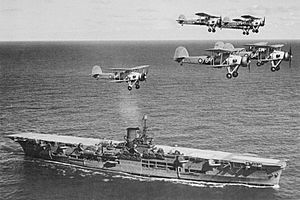
Allied warships lost during the siege:
- One battleship:
- HMS Barham
- Two aircraft carriers:
- HMS Eagle, Ark Royal
- Five cruisers:
- HMS Cairo, Hermione, Manchester, Neptune, Southampton
- 19 destroyers:
- HMS Airedale, Bedouin, Fearless, Foresight, Gallant, Gurkha, Hasty, Hyperion, Jersey, Kandahar, Kingston, Kujawiak (Polish Navy), Lance, Legion, Maori, Mohawk, HMAS Nestor (Royal Australian Navy), HMS Pakenham and Southwold.
- 38 submarines:
- HMS Cachalot, Grampus, Odin, Olympus, Orpheus, Oswald, Undaunted, Union, P36, P38, P48, P222, P311, Pandora, Parthian, Perseus, Rainbow, Regent, Regulus, Saracen, Splendid, Talisman, Tempest, Tetrarch, Thunderbolt, Tigris, Traveller, Triad, Triton, Triumph, Trooper, Turbulent, Upholder, Urge, Usk and Utmost. The Free French Narval and Greek Navy vessel Glaukos, were also lost.
Damage to Buildings and Infrastructure
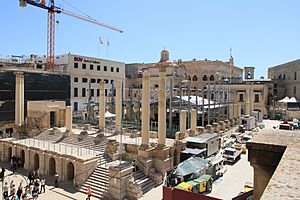
On the crowded island, 5,524 private homes were destroyed. 9,925 were damaged but could be repaired. 14,225 were damaged by bomb blasts. Also, 111 churches, 50 hospitals, and many other public buildings were destroyed or damaged. In total, 30,000 buildings were affected. Famous buildings like the Royal Opera House and parts of old forts were destroyed. Other buildings were badly damaged but rebuilt after the war.
A War Damage Commission was set up. Its job was to pay people whose property was destroyed or damaged during the war.
Axis Shipping Losses
Total Axis losses in the Mediterranean were moderate. 17,240 people were killed at sea. In supplies, the Axis lost 315,090 tons. This was more than what reached Malta. Allied navies sank 773 Axis ships, totaling 1,364,337 tons. Mines sank another 179 ships. Navies and air forces together destroyed 25 ships. Aircraft sank 1,326 ships. In all, 2,304 Axis ships were sunk.
Table of Axis Personnel and Supplies to Libya, 1940:
| Month | Personnel shipped |
Personnel reached |
Supplies shipped |
Supplies reached |
|---|---|---|---|---|
| Jun | 1,358 | 1,308 | 3,618 | 3,608 |
| Jul | 6,407 | 6,407 | 40,875 | 40,875 |
| Aug | 1,221 | 1,221 | 50,669 | 50,669 |
| Sep | 4,602 | 4,602 | 53,669 | 53,669 |
| Oct | 2,823 | 2,823 | 29,306 | 29,306 |
| Nov | 3,157 | 3,157 | 60,778 | 60,778 |
| Dec | 9,731 | 9,731 | 65,556 | 58,574 |
Table of Axis Personnel and Supplies to Libya, 1941:
| Month | Personnel shipped |
Personnel reached |
Supplies shipped |
Supplies reached |
|---|---|---|---|---|
| Jan | 12,491 | 12,214 | 50,505 | 49,084 |
| Feb | 19,557 | 19,557 | 80,357 | 79,173 |
| Mar | 20,975 | 20,184 | 101,800 | 92,753 |
| Apr | 20,698 | 19,926 | 88,597 | 81,472 |
| May | 12,552 | 9,958 | 73,367 | 69,331 |
| Jun | 12,886 | 12,886 | 133,331 | 125,076 |
| Jul | 16,141 | 15,767 | 77,012 | 62,276 |
| Aug | 18,288 | 16,753 | 96,021 | 83,956 |
| Sep | 12,717 | 6,603 | 94,115 | 67,513 |
| Oct | 4,046 | 3,541 | 92,449 | 73,614 |
| Nov | 4,872 | 4,628 | 79,208 | 29,843 |
| Dec | 1,748 | 1,074 | 47,680 | 39,092 |
Table of Axis Personnel and Supplies to Libya, 1942:
| Month | Personnel shipped |
Personnel reached |
Supplies shipped |
Supplies reached |
|---|---|---|---|---|
| Jan | 2,840 | 1,355 | 66,214 | 66,170 |
| Feb | 531 | 531 | 59,468 | 58,965 |
| Mar | 391 | 284 | 57,541 | 47,588 |
| Apr | 1,349 | 1,349 | 151,578 | 150,389 |
| May | 4,396 | 4,241 | 93,188 | 86,439 |
| Jun | 1,474 | 1,249 | 41,519 | 32,327 |
| Jul | 4,566 | 4,435 | 97,794 | 91,491 |
| Aug | 1,281 | 790 | 77,134 | 51,655 |
| Sep | 1,367 | 959 | 96,903 | 77,526 |
| Oct | 1,011 | 631 | 83,695 | 46,698 |
| Nov | 1,031 | 1,031 | 85,970 | 63,736 |
| Dec | 5 | 5 | 12,981 | 6,151 |
- periods the Regia Aeronautica was the only enemy air force in action against Malta
- periods the Luftwaffe made significant efforts against Malta
- influence of the Royal Navy Force K operations against Axis shipping
- influence of Bristol Beaufighter operations against Axis shipping
See also
- Malta Convoys
- Operation Herkules
- Malta Command
- Military history of Gibraltar during World War II
- Military history of the British Commonwealth in the Second World War
- Adrian Warburton
- George Beurling
- List of British military equipment of World War II
- List of Italian Army equipment in World War II
- List of German military equipment of World War II


